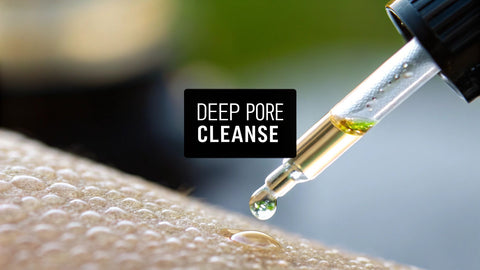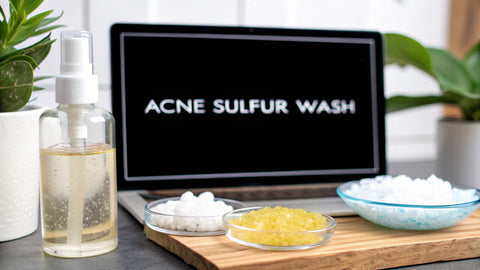The Correct Skin Care Order Of Application

Ever felt like you’re using all the right products but still not seeing the results you want? The secret might not be what you’re using, but how you’re using it. Getting the order of your skincare steps right is fundamental, especially when you’re fighting stubborn acne.
The golden rule I always tell my clients is simple: apply your products from the thinnest consistency to the thickest. This little trick ensures everything actually gets absorbed properly, letting each product do its job without being blocked by another.
Why Your Skincare Order Actually Matters
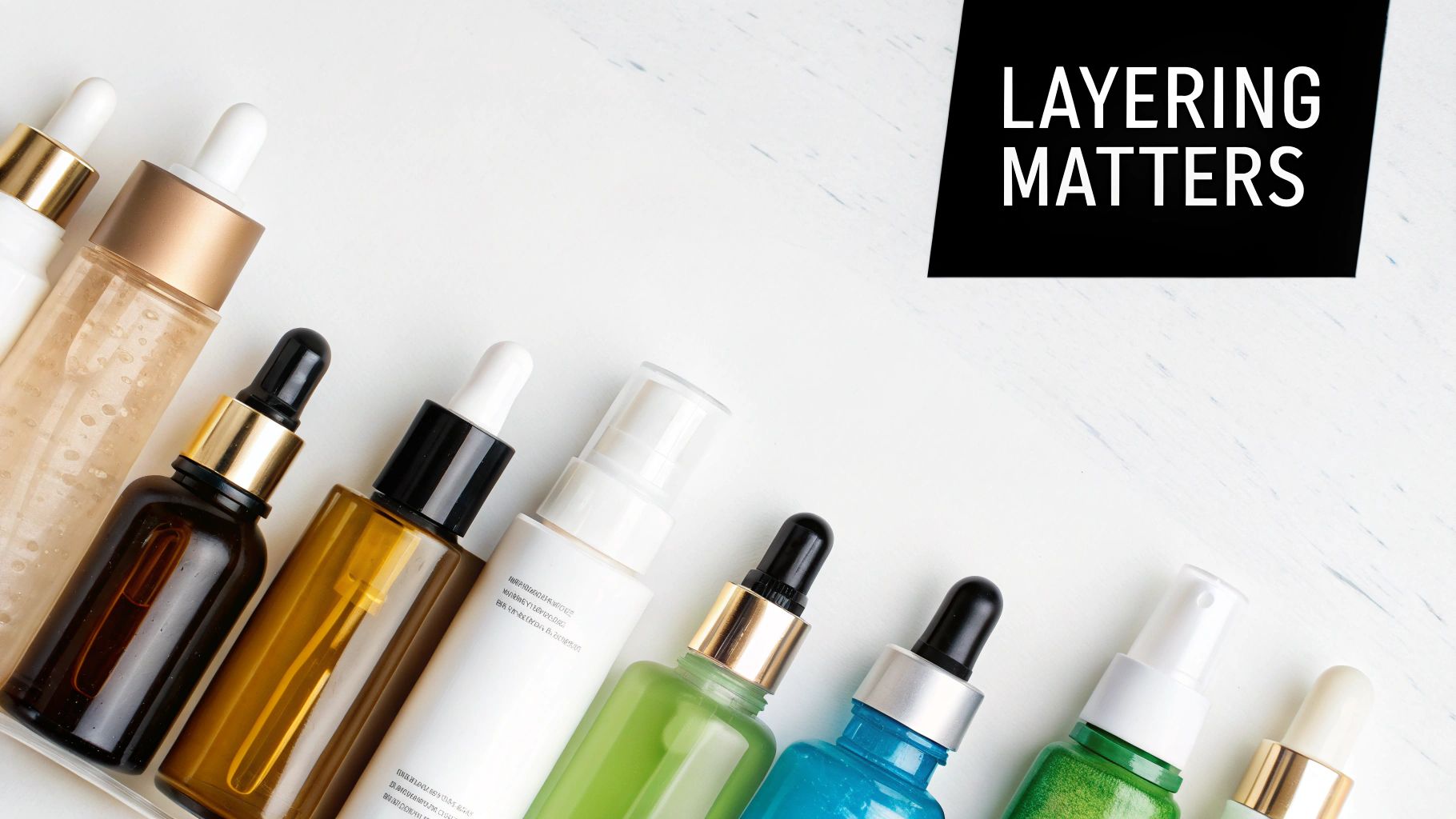
If you've ever splurged on a promising new acne treatment only to be disappointed, the application order could be the culprit. Think of it this way: putting a thick, creamy moisturizer on first is like trying to water a plant through a plastic sheet. You’re creating a barrier that prevents anything else from getting through.
When that happens, your lightweight serums and powerful acne-fighting treatments just sit on the surface, unable to penetrate your skin and get to the source of the breakouts. It's a common mistake, but fixing it can completely change your skin.
The Science Of Absorption
This "thinnest-to-thickest" rule isn't just an old wives' tale; it’s grounded in cosmetic science. Products with a watery base, like the targeted serums from Neutralyze, are formulated with smaller molecules designed to sink deep into the skin. This allows potent, acne-fighting ingredients to reach the deeper layers of the epidermis where they can be most effective.
On the other hand, heavier creams and oils have larger molecules. Their job is to sit closer to the surface, where they form a protective barrier that seals in moisture and all the good stuff you just applied. Layering correctly ensures every product performs exactly as it was designed to.
Building A Consistent Routine
Of course, the perfect order doesn't mean much without consistency. Sticking to a daily regimen is what truly delivers clear skin over time. It's a practice that's become mainstream for a good reason—it works.
A recent survey found that 74% of women have both a morning and evening routine, using about three products each time. The classic dermatologist-recommended sequence of cleanser, treatment, moisturizer, and sunscreen is popular because it’s effective. You can dive deeper into skincare usage trends and statistics to see just how common structured routines are now.
Key Takeaway: The effectiveness of powerful, science-backed ingredients depends heavily on their ability to reach the target area. Correctly layering your skincare ensures that active formulas penetrate your skin first, allowing them to work on clearing acne before heavier products seal in moisture.
For a quick reference, here’s a simple table outlining the general flow for your morning and evening routines.
Quick Guide To Product Layering
| Step | Morning (AM) Routine | Evening (PM) Routine |
|---|---|---|
| 1 | Cleanser | Cleanser (or Double Cleanse) |
| 2 | Toner / Essence (Optional) | Toner / Essence / Exfoliant |
| 3 | Acne Treatments / Serums | Acne Treatments / Serums / Retinoids |
| 4 | Eye Cream | Eye Cream |
| 5 | Moisturizer | Moisturizer / Night Cream |
| 6 | Sunscreen (SPF 30+) | Facial Oil (Optional) |
Keep this guide handy as you build your routine. Getting the sequence right is a simple change that can make a world of difference in your journey to clear skin.
Building Your Morning Acne Defense Routine
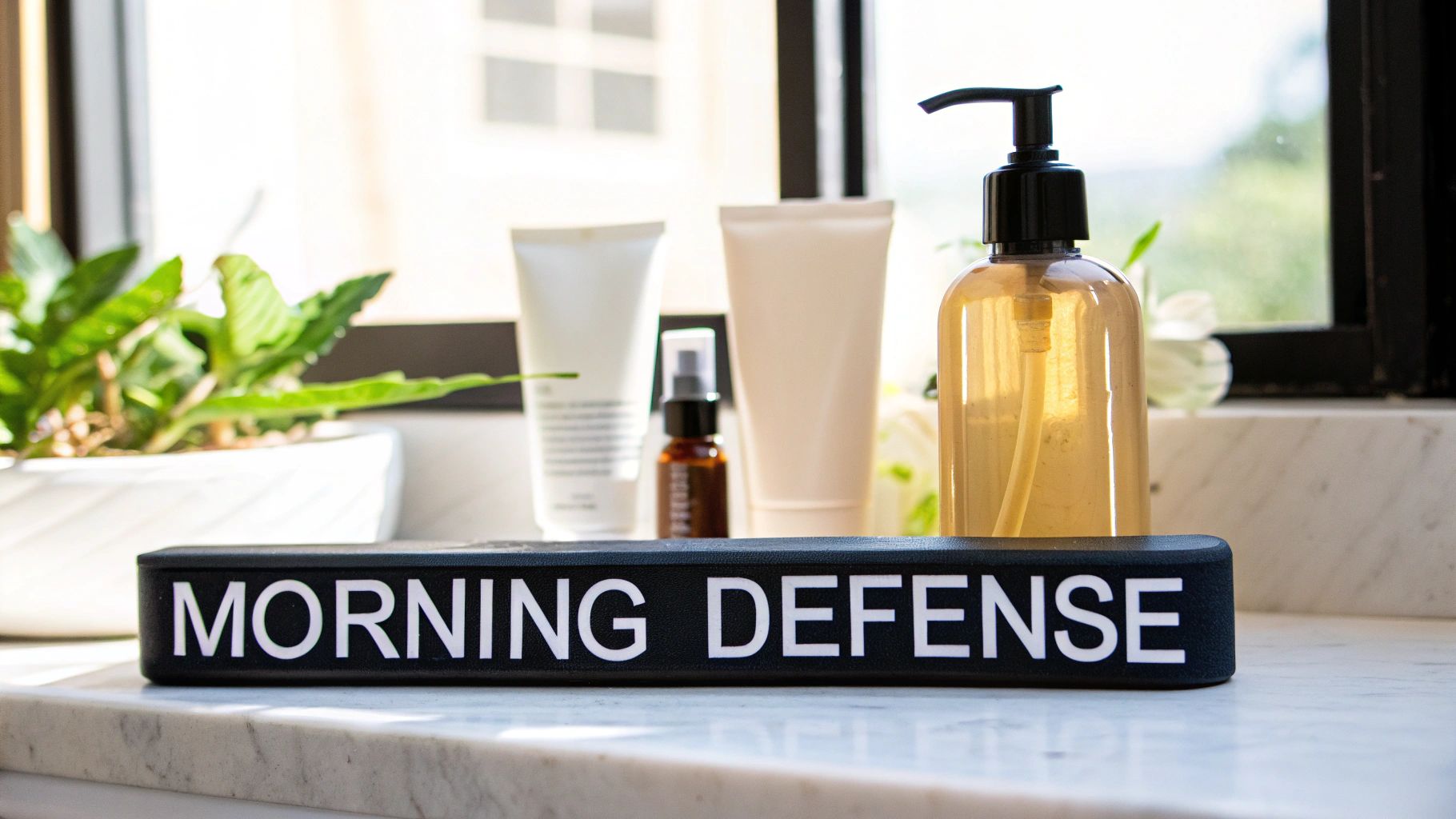
Your morning skincare routine is all about setting your skin up for success. It’s not just about wiping the sleep from your eyes; it's about building a protective shield against everything the day throws at you—from UV rays and pollution to the excess oil that fuels breakouts. Think of it as your daily armor.
Getting the skin care order of application right is crucial in the morning. You want to make sure your protective layers are applied correctly so your skin stays balanced, hydrated, and ready to fight off acne triggers all day long.
Start With A Pore-Clearing Cleanse
First thing's first: cleanse. Overnight, your skin has been busy producing oil and shedding dead cells. A good morning wash clears all that away, giving you a fresh, clean canvas for the rest of your products.
For acne-prone skin, your choice of cleanser is everything. You need something that gets the gunk out of your pores without stripping your skin's natural moisture barrier. Using a harsh, drying cleanser is a classic mistake—it can trigger your skin to produce even more oil to compensate.
This is where an ingredient like Salicylic Acid becomes your best friend. As a Beta Hydroxy Acid (BHA), it is oil-soluble, allowing it to penetrate deep into your pores to dissolve the mix of sebum and dead skin cells that leads to blackheads and whiteheads. It's a highly effective, yet gentle, exfoliant for keeping pores clear.
Expert Insight: Kicking off your morning with a Salicylic Acid-based cleanser, like the Neutralyze Face Wash, is the perfect first step. Neutralyze harnesses the power of Salicylic Acid in a carefully balanced formula that provides a deep, pore-clearing cleanse without causing irritation, setting the stage for a clear, calm complexion all day long.
Layer Targeted Treatments And Serums
With your skin clean and prepped, it's ready to drink up any active ingredients you apply. Now is the time for targeted treatments and lightweight serums. Just remember the golden rule of layering: "thinnest-to-thickest." Watery formulas always go on before heavier creams.
Your morning treatments should focus on hydration, antioxidant protection, and keeping inflammation in check.
- Hyaluronic Acid: A total moisture magnet. It pulls water into the skin, keeping it plump and hydrated. When skin is properly hydrated, it’s less likely to go into oil-production overdrive.
- Niacinamide: This form of vitamin B3 is a real multitasker. It helps control oil, calms redness, and strengthens the skin's barrier. It's a fantastic, well-rounded ingredient for managing acne.
When you apply these, a few drops are all you need. Gently pat them into your skin for even coverage and better absorption. Give each layer about 30-60 seconds to sink in before you move on.
Seal It All In With The Right Moisturizer
Yes, even if your skin is oily and breaking out, you absolutely need to moisturize. This step is non-negotiable. A good moisturizer locks in all the beneficial ingredients you just applied and keeps your skin barrier healthy—and a healthy barrier is your best defense against bacteria and irritation.
The trick is to pick the right kind of moisturizer. Always go for one that is lightweight and non-comedogenic. That's just a fancy way of saying it’s been designed specifically not to clog your pores.
Look for gel or water-based formulas that feel refreshing, not heavy or greasy. This step ensures your skin stays comfortably hydrated without feeling weighed down.
The Final, Crucial Step: Sunscreen
If you only have time for one step after cleansing, make it this one. Sun exposure is a huge trigger for acne-prone skin. It causes inflammation and can lead to post-inflammatory hyperpigmentation (those stubborn dark spots that stick around long after a pimple is gone).
Applying a broad-spectrum sunscreen with at least SPF 30 is the single most important defensive play you can make for your skin. It shields you from UVA and UVB rays, prevents premature aging, and helps your existing breakouts heal better.
Just like your moisturizer, make sure your sunscreen is non-comedogenic. Mineral-based formulas with zinc oxide or titanium dioxide are often a great choice, as they tend to be less irritating for sensitive, acne-prone skin types.
The idea of a multi-step routine has become a global standard for healthy skin, largely thanks to the influence of the iconic 10-step Korean skincare regimens. Today, women use an average of five skincare products daily, and following a consistent order—cleanser, serum, moisturizer, and sunscreen—is proven to boost how well products work. You can learn more about how beauty industry trends highlight the importance of routine.
By mastering this morning skin care order of application, you're not just fighting existing acne—you're playing smart defense for a clearer, healthier future.
Your Nighttime Routine for Repair and Renewal
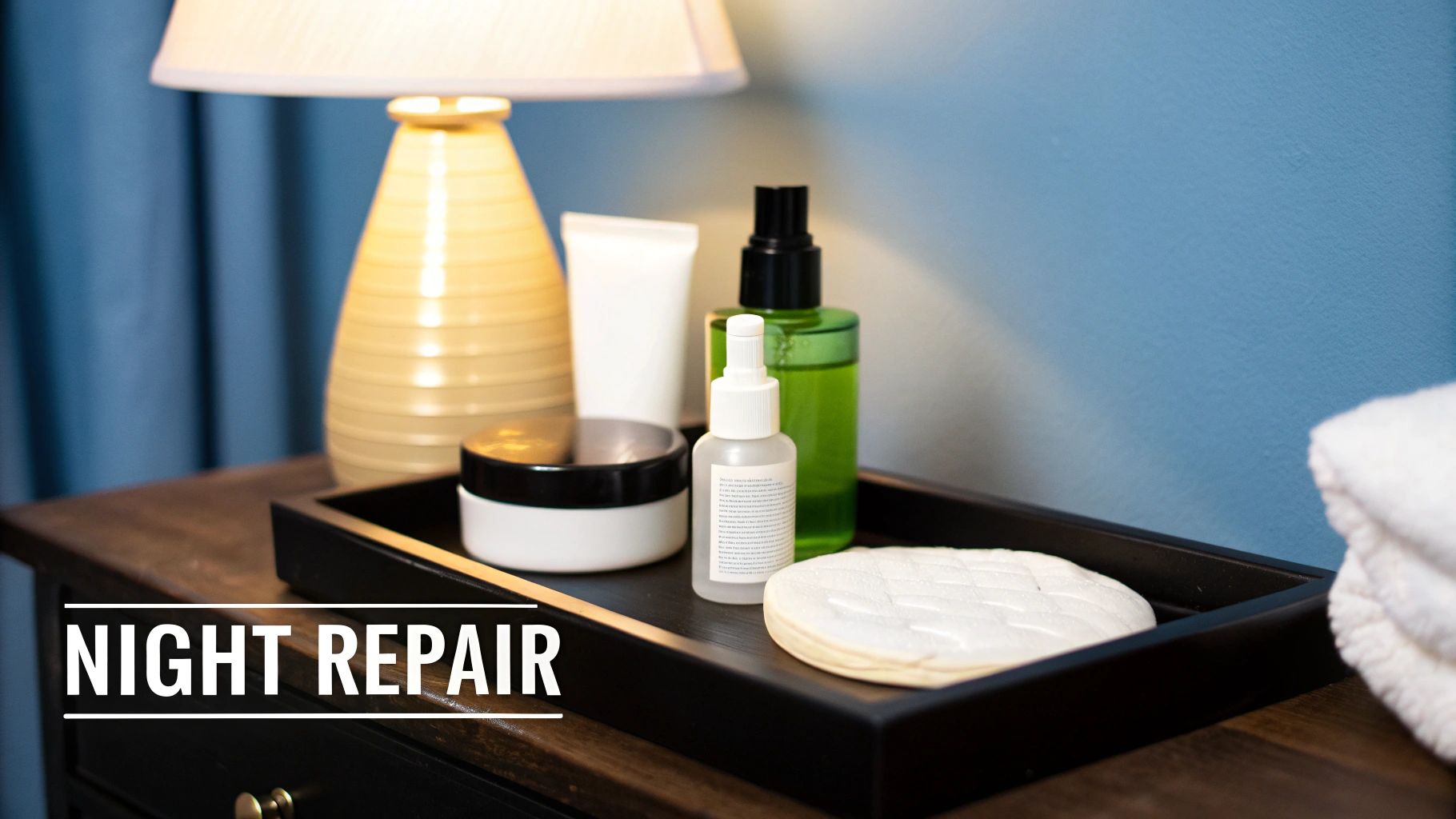
If your morning routine is all about defense, your nighttime skincare is about going on the offense. As you sleep, your skin’s natural repair cycle kicks into high gear. This makes it the absolute best time to use powerful, corrective ingredients that can work their magic uninterrupted to tackle existing acne and head off future breakouts.
This is your prime time for renewal. Getting the skin care order of application right at night is non-negotiable because it ensures these potent formulas can actually do their job. By clearing away the day's grime and layering treatments correctly, you’re creating the perfect environment for your skin to heal, so you can wake up to a calmer, clearer complexion.
The Power of the Double Cleanse
Before you can even think about applying treatments, you need to get your skin genuinely clean. Throughout the day, your face collects a stubborn film of makeup, sunscreen, oil, and city pollution. Trust me, a single pass with your usual cleanser just won't cut it.
This is where the double cleanse method becomes a game-changer. It’s a simple two-step process that guarantees you’re starting with a completely fresh canvas.
- First Cleanse (Oil-Based): Start with an oil-based cleanser or a good micellar water. The logic here is simple: like dissolves like. The oil in the cleanser effortlessly breaks down oil-based impurities—like those in your foundation and SPF—lifting them off the skin without any harsh scrubbing.
- Second Cleanse (Water-Based): Now, follow up with your regular water-based face wash. This second step whisks away any leftover residue from the first cleanse and deeply purifies your pores, targeting water-based gunk like sweat and dirt.
This one-two punch ensures your skin is perfectly prepped and ready to soak up all the active ingredients you're about to apply.
Unleash the Power of Active Treatments
With your skin pristine, it’s time to bring in the heavy hitters. Your evening routine is the ideal stage for exfoliants and targeted treatments designed to resurface skin, clear out congestion, and fight acne-causing bacteria.
One of the most impressive ingredients for this job is Mandelic Acid. As an Alpha Hydroxy Acid (AHA), it has a larger molecular structure than other AHAs like glycolic acid. This unique property means it penetrates the skin more slowly and evenly, providing powerful exfoliation with significantly less irritation—a huge benefit for sensitive, acne-prone skin.
Mandelic Acid works by dissolving the bonds between dead skin cells, promoting cell turnover to reveal a brighter, smoother complexion. It's also celebrated for its antibacterial properties, which help to directly combat breakouts. That’s precisely why it's the hero ingredient in the Neutralyze Clearing Serum—it offers a multi-pronged attack on acne for visible, lasting results.
Key Insight: Applying a Mandelic Acid-based treatment right after cleansing allows it to work at peak power. It gently exfoliates, unclogs pores, and reduces inflammation while you sleep, making it a cornerstone of any effective PM acne routine. Neutralyze's formula ensures you get all the benefits without the harshness.
Serum Application vs. Spot Treatment
After applying your all-over treatment serum, you might need to call in reinforcements for a few particularly stubborn pimples. This is where a dedicated spot treatment comes in. The key is understanding when and where to use each one for maximum impact.
- All-Over Serums: These are formulated for your entire face (or at least all your breakout-prone areas). They treat existing acne while working proactively to prevent new blemishes from cropping up, improving your overall skin tone and texture in the process. A serum like Neutralyze's, with Mandelic Acid, is designed for broad application to maintain skin clarity.
- Spot Treatments: These are highly concentrated formulas meant to be dabbed directly onto individual pimples. They deliver a potent, targeted dose of acne-fighting ingredients to shrink a blemish fast. The Neutralyze Spot Treatment is perfect for this, as its advanced formula can rapidly reduce inflammation without drying out the surrounding skin.
A good rule of thumb is to apply your all-over serum first, give it a minute or two to absorb, and then carefully dab the spot treatment onto any active breakouts. This layering strategy ensures both products can work without interfering with one another.
Hydrate and Support With a Nourishing Moisturizer
The final, and absolutely crucial, step in your nighttime routine is moisturizer. After using powerful actives like Mandelic Acid, your skin needs hydration and support to fuel its repair process. A good night cream does far more than just moisturize; it seals in your treatments and helps strengthen your skin's natural barrier.
When your skin barrier is compromised, it can't properly defend against bacteria or hold onto moisture, which often leads to more breakouts and irritation. Using a nourishing, non-comedogenic moisturizer helps fortify this barrier, keeping your skin balanced and resilient. Think of your PM routine as essential repair time, allowing for the optimal use of powerful acne-fighters as well as effective wrinkle reducing treatments.
Look for moisturizers with ingredients like ceramides, hyaluronic acid, and niacinamide. These are fantastic for hydrating, calming, and restoring the skin. Applying a generous layer as your very last step locks everything in, ensuring you get the maximum benefit from your entire PM routine. You’ll wake up with skin that feels refreshed, hydrated, and one step closer to clear.
Understanding How Your Ingredients Play Together
Once you've got the "thinnest-to-thickest" rule down, it's time to get a little more strategic. The real magic in skincare happens when you understand how your active ingredients actually interact with each other. This goes way beyond texture and dives into product chemistry.
Get it right, and you can seriously amplify your results. Get it wrong, and you might cause irritation or, even worse, make your expensive products completely useless.
Think of it like being a chef. You wouldn't just throw all your ingredients into a pot at once, right? The order and timing matter. The same is true for your face.
A Quick Word on pH and Wait Times
You don’t need to be a chemist, but knowing a little about pH can be a game-changer for your skin. The pH scale simply measures how acidic or alkaline something is. Your skin is happiest at a slightly acidic pH of around 4.7 to 5.75—that's its sweet spot for maintaining a healthy, protective barrier.
Many of the heavy-hitters in an acne routine, like Salicylic Acid or Mandelic Acid, do their best work at a very low pH. But other ingredients, like retinoids, prefer a pH that’s closer to your skin's natural state.
If you apply a low-pH acid and immediately follow it with a higher-pH product, you can actually neutralize the acid before it has a chance to work. This is where a little patience pays off.
My go-to advice: After you apply something with a low pH, like an acid-based toner or serum, just hang out for a few minutes. Let it sink in and do its thing at its optimal pH before you move on to the next step.
Smart Pairings: What to Mix and What to Skip
Building a powerful routine is all about creating synergy between your products. Some ingredients are true power couples, making each other even better when used together.
A perfect example is pairing up hydrating ingredients. We actually have a whole guide on building a skincare routine with Niacinamide and Hyaluronic Acid that shows how beautifully they work in tandem to hydrate and strengthen your skin.
On the flip side, some potent ingredients are best kept in separate routines to avoid overwhelming your skin. It’s not that they’re “bad” together, but the combined intensity can lead to redness, peeling, and a damaged moisture barrier—exactly what you don't want when you're trying to clear up acne.
To make things easier, here's a quick cheat sheet for some of the most common active ingredients you'll find in an acne-focused routine.
Skincare Ingredient Compatibility Guide
Navigating the world of active ingredients can feel like a chemistry class you didn't sign up for. This quick reference table is designed to help you pair ingredients like a pro and avoid common combinations that can lead to irritation or render your products ineffective.
| Ingredient | Pairs Well With | Use With Caution / Avoid |
|---|---|---|
| AHAs/BHAs | Hyaluronic Acid, Niacinamide, SPF | Retinoids, Vitamin C (in the same routine) |
| Retinoids | Hyaluronic Acid, Niacinamide, Peptides, SPF | Vitamin C, Benzoyl Peroxide, AHAs/BHAs (can be too irritating together) |
| Vitamin C | Vitamin E, Ferulic Acid, Hyaluronic Acid, SPF | AHAs/BHAs, Retinoids (best used in separate routines, e.g., Vit C in AM, others in PM) |
| Niacinamide | Almost Everything! Retinoids, Hyaluronic Acid, AHAs/BHAs, Vitamin C | High-concentration Vitamin C (L-Ascorbic Acid) can cause flushing in some people, but it's rare with modern formulas. |
| Benzoyl Peroxide | Niacinamide, Hyaluronic Acid, SPF | Retinoids (can be very drying together; alternate nights), Vitamin C (can oxidize it) |
Remember, this is a general guide. The most important rule is to listen to your own skin. What works for someone else might not work for you, so always introduce new combinations slowly.
Making the Routine Your Own
There’s a reason the personalized skincare market is booming—it was valued at $25.1 billion for a reason! We're all finally realizing that a one-size-fits-all approach doesn't work. The real key is tailoring your product order and frequency to what your skin needs at any given moment.
For acne-prone skin, that might mean using your most powerful treatment, like a retinoid, only a few nights a week. On your "off" nights, you can focus on gentle, hydrating, or calming serums to give your skin a break and help rebuild its barrier.
If your skin starts feeling red, tight, or starts stinging, that’s your signal to pull back. Simplify your routine and focus on the basics for a few days. Building a resilient, clear complexion is a marathon, not a sprint.
Putting It All Together With Sample Routines
Knowing the rules of layering is one thing, but seeing how it all comes together in a daily routine makes a world of difference. So, let’s build two simple, powerful routines for anyone dealing with moderate to severe acne.
We’ll use Neutralyze products as the core of these examples to show you exactly how to get the most from their science-backed ingredients. These sample routines lay out the complete skin care order of application to help you fight breakouts, soothe inflammation, and get your skin back on track.
An Effective Morning Routine for Acne Protection
Your morning routine is all about two things: clearing away any oil and bacteria that built up overnight and creating a protective shield for the day ahead. Get this part right, and you're already halfway to preventing new breakouts.
- Start with a Clean Slate: Begin with the Neutralyze Face Wash. Its Salicylic Acid formula is perfect for the morning—it gently exfoliates and gets deep into your pores to clear out oil and dead skin cells without leaving your face feeling tight or stripped.
- Apply Your All-Over Treatment: While your skin is still a little damp, which helps with absorption, apply the Neutralyze Clearing Serum. This isn’t a spot treatment; you want a thin layer over your entire face. The Mandelic Acid works tirelessly to improve skin texture and keep future breakouts from forming.
- Hydrate and Protect Your Barrier: Next up is a lightweight, non-comedogenic moisturizer. Seriously, don't skip this. Hydrated skin is healthy skin. Look for ingredients like hyaluronic acid or ceramides to keep your skin balanced without clogging pores.
- Finish with Sunscreen (Non-Negotiable): This is the most critical step. Apply a broad-spectrum sunscreen with at least SPF 30. Sun exposure can make acne worse and turn old pimples into dark spots that stick around for months. Sunscreen prevents that damage.
That’s it. Four simple steps that create a strong defense against the grime and stressors of the day.
A Powerful Nighttime Routine for Repair
At night, your skin goes into full-on repair mode. This is your chance to use more targeted treatments to tackle existing acne and help your skin heal while you sleep.
- Consider a Double Cleanse: If you wear makeup or a heavy-duty sunscreen, start with an oil-based cleanser. It'll dissolve everything on the surface. Then, follow up with your Neutralyze Face Wash to get your pores completely clean and prepped for the next steps.
- Apply Your All-Over Treatment Again: Just like in the morning, smooth the Neutralyze Clearing Serum across your face. Using Mandelic Acid consistently helps speed up cell turnover and keeps acne-causing bacteria in check.
- Target Active Breakouts: Now it's time to bring in the big guns for any angry, active blemishes. Dab a thin layer of the Neutralyze Spot Treatment directly onto individual pimples. Its concentrated formula gets to work fast, helping to shrink the pimple and reduce redness.
- Lock It All In: Finish with a nourishing moisturizer. You can go with something a little more hydrating than your morning lotion, but make sure it’s still non-comedogenic. This final layer seals in all your treatments and supports your skin’s natural healing process overnight.
Pro Tip: When you're first introducing active ingredients like Salicylic and Mandelic Acid, pay close attention to how your skin feels. A great way to start is by using the Clearing Serum just once a day (at night) for a week or two. If your skin is happy, you can build up to using it twice a day.
This visual guide really helps break down the tricky parts of layering, like why pH levels matter and when to pause between products.
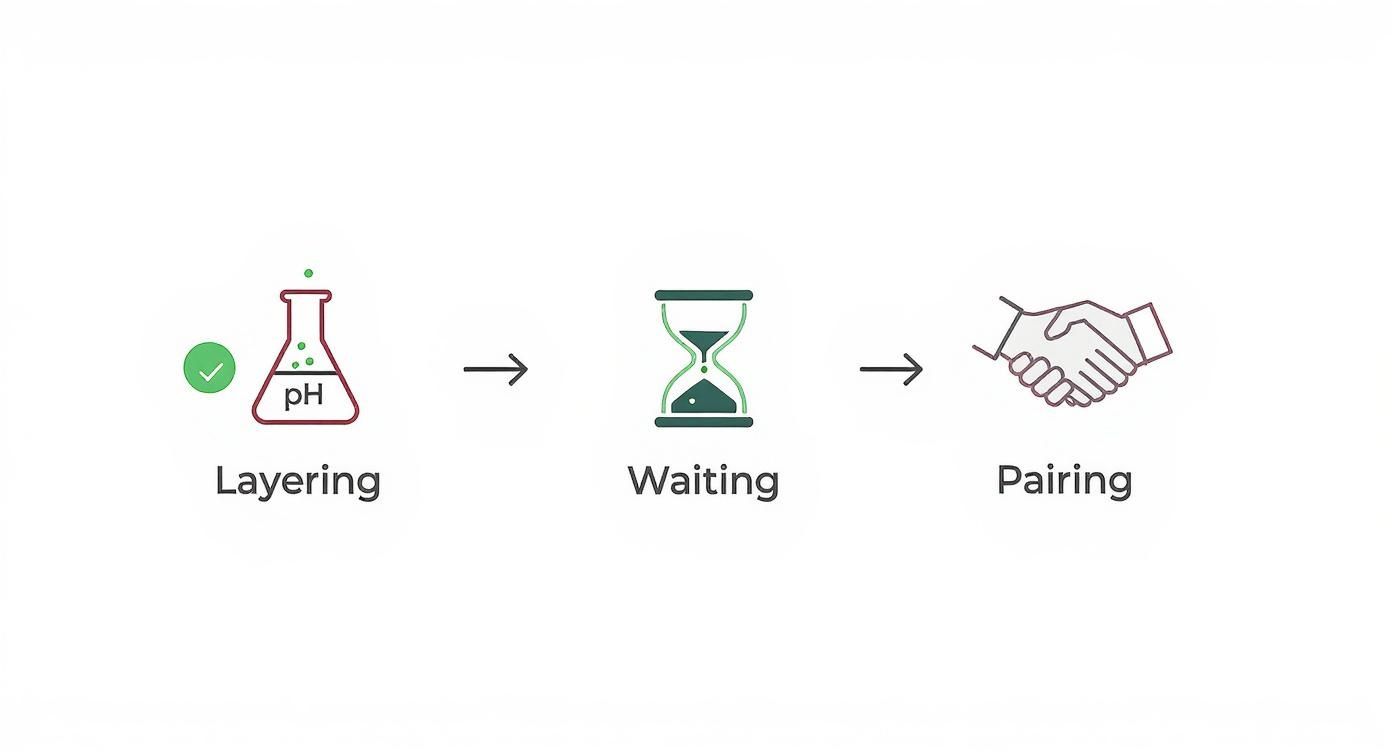
As the graphic shows, a successful routine isn't just about what you apply, but how you apply it. Giving each product a minute to absorb is especially important for pH-dependent actives, like the powerful acids found in Neutralyze products, to ensure they can work effectively.
Common Questions About Skincare Layering
Even the most meticulous routine raises questions about what goes on first. Mastering your layering takes a little experimentation—and a few insider tips never hurt. Get these basics right, and those potent ingredients will deliver exactly what you paid for.
How Long Should You Wait Between Skincare Steps?
It’s the question everyone asks: how much downtime before the next product? For most serums and moisturizers, a brief pause—30 to 60 seconds—is plenty. That little window prevents pilling and lets each formula sink in.
With strong actives like the mandelic acid in Neutralyze Clearing Serum or any retinoid, be more patient. Wait until the layer feels completely dry. This ensures the pH stays balanced and the treatment can work at full strength.
Always apply sunscreen at least 15 minutes before heading outdoors. This gives the UV filters enough time to form a solid protective barrier.
Where Does Spot Treatment Fit In?
Spot treatments are your secret weapon for surprise breakouts. For maximum potency, they should be applied to clean, dry skin right after cleansing, allowing the active ingredients to penetrate the blemish without any barriers.
If your skin is on the sensitive side, you can apply your moisturizer first to create a buffer, then dot on your spot treatment. This can help minimize potential irritation.
- For best results, apply a thin film of Neutralyze Spot Treatment directly to each affected area after washing. Its targeted formula is designed to quickly reduce inflammation.
- Let it dry fully before moving on to your next serum or moisturizer.
This order maximizes efficacy while safeguarding the surrounding skin.
Can You Double Cleanse Oil-Prone Skin?
It might sound counterintuitive, but an oil-based cleanser is a fantastic first step for oily, acne-prone skin. The "double cleanse" method is highly effective because it thoroughly removes buildup without stripping your skin.
- First, an oil-based formula dissolves makeup, sunscreen, and excess sebum.
- Second, a water-based wash—like Neutralyze Face Wash with its pore-clearing Salicylic Acid—removes any remaining residue and deeply purifies the skin.
This comprehensive two-step cleanse helps maintain a healthy skin barrier, preventing the cycle of over-drying and excess oil production that can worsen acne.
Ready to build a routine that delivers real results? Neutralyze provides the science-backed, targeted treatments you need to take control of your acne. With powerful ingredients formulated to work together, you can finally achieve the clear, calm skin you deserve.
Discover the complete Neutralyze system and start your journey to clearer skin today!

